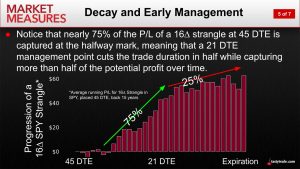Tips and Tactics to Fight Time Decay
Short options traders rely on the power of time decay to produce profits, but the addition of trade management techniques can help maximize profits, while simultaneously helping to reduce expiration-related risks.

A key to options trading centers on an understanding of theta and time decay, and that’s because options—unlike stocks—have finite lives.
Theta is the parameter that reports the amount of value lost from a given option as time passes. It is quoted in dollars/cents lost per day.
For example, if one purchases a call option worth $2.00, and the associated theta of that option is $0.10, then that option will theoretically be worth $1.80 after it is held for two days. The economic reality of theta explains why options traders and investors can make money even when the underlying stock sits still.
Time decay, on the other hand, speaks to the broader reality, that as options move closer to expiration, they lose value. The existence of time decay is one reason that short options strategies exhibit such high historical win rates.
And while time decay and theta are powerful in their own right, investors and traders can maximize the potential of short options trading by also incorporating tactics that involve trade duration and trade management—two concepts that speak to the timing of trade entry and trade exit.
Trade duration speaks to the amount of time left until expiration, and is usually expressed as days-to-expiration, or DTE. Previous research conducted by tastytrade has indicated that when it comes to days until expiration, 45 may be a sweet spot for short options.
And that’s where trade management also comes into play.
Instead of simply opening a new short options trade with approximately 45 days until expiration, and waiting until the trade rolls off naturally on expiration day, options market participants can utilize trade management techniques to help maximize potential rewards and minimize potential risks in a given position—and across the portfolio.
That’s because additional tastytrade research has consistently illustrated that the bulk of profits received from theta/time decay are accrued early in the cycle, and that by closing short options trades prior to expiration week, traders can simultaneously reduce associated expiration-related risks.
The slide below highlights how 75% of the potential profits from a low delta short strangle are typically accrued in the first 21 days, particularly for out-of-the-money, or OTM, options.

Assuming an investor or trader buys into the value of trade management, there are also additional choices available for applying such a system.
Generally speaking, open positions can be managed according to P/L or according to the passing of time, two concepts which are generally referred to as managing winners/losers or managing early.
At its core, managing winners/losers is all about closing high-performing positions while they are ahead, or closing losing positions before they get out of control.
Managing early, on the other hand, relies on the fact that theta decay decelerates as expiration gets closer, meaning that traders may prefer to close trades as potential rewards decrease, and potential risks increase—based on the passing of time, not P/L.
A couple well-known approaches to managing winners at tastytrade include closing strangles at 50% of the credit received, and closing straddles at 25% of the credit received. In the former case, this would mean that if you sold a strangle for $2.00, the strategy would call for closing the position once the market value of the strangle had decayed down to $1.00.
In terms of managing early, the goal is to systematically remove positions from the portfolio before expiration, after much of the time premium (i.e. extrinsic value) has already decayed out of the option’s value. Utilizing this approach, a trader might decide to close positions after a certain number of trading days has elapsed or with a certain number of days left until expiration.

The actual approach to entering and exiting positions will vary by trader/investor, depending on his/her unique approach, outlook and risk profile. And like most things in the market, the best way to evaluate one’s comfort level is to mock trade (i.e. paper trade) a new trading or risk management approach before deploying it live in the market.
Readers interested in learning more about this topic are encouraged to review a previous episode of Market Measures on the tastytrade network which outlines a market study comparing the relative pros/cons of different trade management approaches.
The links below should also provide further insight on the topics covered in this post:
- Market Measures: Time Decay and Trade Management
- The Skinny on Options Math: Understanding Changing Thetas
- Market Measures: Comparing Trade Management Approaches
- Best Practices: The Importance of 45 and 21 Days to Expiration
For updates on everything moving the markets, readers can also tune into TASTYTRADE LIVE—weekdays from 7 a.m. to 4 p.m. CST—at their convenience.
Sage Anderson is a pseudonym. He’s an experienced trader of equity derivatives and has managed volatility-based portfolios as a former prop trading firm employee. He’s not an employee of Luckbox, tastytrade or any affiliated companies. Readers can direct questions about this blog or other trading-related subjects, to support@luckboxmagazine.com.




















